诗歌欣赏英语论文
- 格式:doc
- 大小:37.50 KB
- 文档页数:4
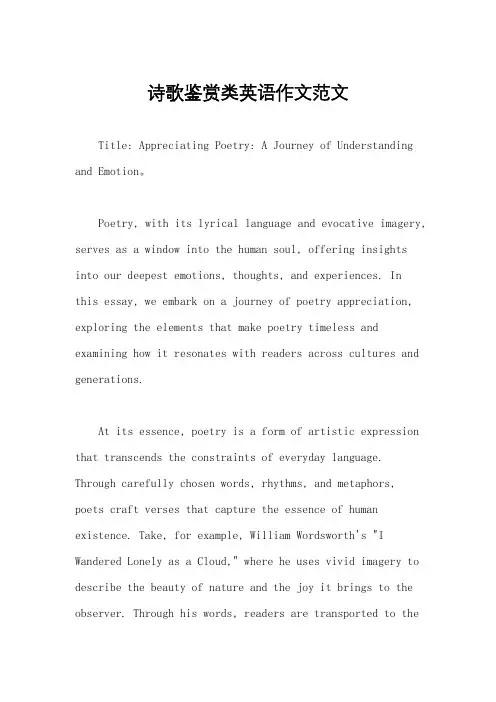
诗歌鉴赏类英语作文范文Title: Appreciating Poetry: A Journey of Understanding and Emotion。
Poetry, with its lyrical language and evocative imagery, serves as a window into the human soul, offering insights into our deepest emotions, thoughts, and experiences. Inthis essay, we embark on a journey of poetry appreciation, exploring the elements that make poetry timeless and examining how it resonates with readers across cultures and generations.At its essence, poetry is a form of artistic expression that transcends the constraints of everyday language. Through carefully chosen words, rhythms, and metaphors, poets craft verses that capture the essence of human existence. Take, for example, William Wordsworth's "I Wandered Lonely as a Cloud," where he uses vivid imagery to describe the beauty of nature and the joy it brings to the observer. Through his words, readers are transported to thetranquil meadows and azure skies, experiencing a sense of wonder and awe akin to the poet's own.One of the most captivating aspects of poetry is its ability to evoke emotions in the reader. Whether it's love, longing, sadness, or joy, poetry has the power to stir the deepest recesses of our hearts. Consider the haunting beauty of Edgar Allan Poe's "The Raven," with its melancholic refrain of "Nevermore." Through Poe's masterful use of symbolism and repetition, readers are drawn into the narrator's despair, feeling the weight of his grief and loss. Such is the power of poetry to transcend time and space, connecting us to the universal experiences of humanity.Moreover, poetry serves as a reflection of the cultural and historical context in which it is written. From the ancient epics of Homer to the modernist experiments of T.S. Eliot, each poetic work bears the imprint of its era, offering valuable insights into the values, beliefs, and concerns of society at that time. For instance, Langston Hughes' "Harlem" captures the disillusionment andfrustration of African Americans during the Harlem Renaissance, expressing the deferred dreams and aspirations of a marginalized community. Through his poignant verses, Hughes gives voice to the struggles and aspirations of an entire generation, making poetry not just a form ofartistic expression but also a powerful tool for social commentary and change.In addition to its emotional and cultural resonance, poetry also challenges readers to engage with language in new and unexpected ways. Unlike prose, which follows conventional grammatical rules and narrative structures, poetry often defies convention, playing with form, rhythm, and sound to create meaning. Consider the experimental poetry of e.e. cummings, where words are stripped of their conventional meanings and arranged in unconventional patterns to evoke emotions and sensations. Through his playful manipulation of language, cummings invites readers to experience the world anew, challenging them to question their preconceived notions and embrace the beauty of ambiguity and uncertainty.In conclusion, poetry is a multifaceted art form that enriches our lives in myriad ways. From its ability toevoke emotions and provoke thought to its capacity for cultural expression and linguistic innovation, poetry continues to captivate and inspire readers across the globe. As we immerse ourselves in the timeless verses of the poets, we embark on a journey of self-discovery and enlightenment, finding solace, meaning, and beauty in the rhythmic cadence of words.。
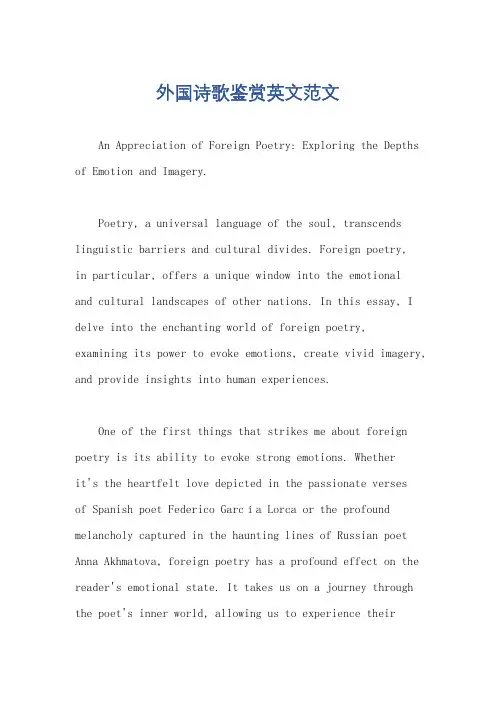
外国诗歌鉴赏英文范文An Appreciation of Foreign Poetry: Exploring the Depths of Emotion and Imagery.Poetry, a universal language of the soul, transcends linguistic barriers and cultural divides. Foreign poetry,in particular, offers a unique window into the emotionaland cultural landscapes of other nations. In this essay, I delve into the enchanting world of foreign poetry, examining its power to evoke emotions, create vivid imagery, and provide insights into human experiences.One of the first things that strikes me about foreign poetry is its ability to evoke strong emotions. Whetherit's the heartfelt love depicted in the passionate versesof Spanish poet Federico García Lorca or the profound melancholy captured in the haunting lines of Russian poet Anna Akhmatova, foreign poetry has a profound effect on the reader's emotional state. It takes us on a journey through the poet's inner world, allowing us to experience theirjoys, sorrows, and innermost thoughts.Another captivating aspect of foreign poetry is its vivid imagery. Poets from various cultures employ unique imagery to create striking visual representations of their ideas and emotions. For instance, the nature-inspired imagery of Japanese poet Bashō, with its emphasis on.。
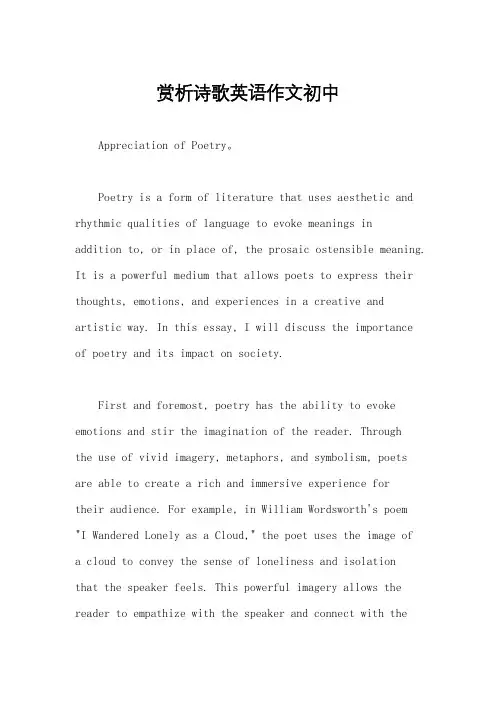
赏析诗歌英语作文初中Appreciation of Poetry。
Poetry is a form of literature that uses aesthetic and rhythmic qualities of language to evoke meanings inaddition to, or in place of, the prosaic ostensible meaning. It is a powerful medium that allows poets to express their thoughts, emotions, and experiences in a creative andartistic way. In this essay, I will discuss the importanceof poetry and its impact on society.First and foremost, poetry has the ability to evoke emotions and stir the imagination of the reader. Throughthe use of vivid imagery, metaphors, and symbolism, poets are able to create a rich and immersive experience fortheir audience. For example, in William Wordsworth's poem"I Wandered Lonely as a Cloud," the poet uses the image ofa cloud to convey the sense of loneliness and isolationthat the speaker feels. This powerful imagery allows the reader to empathize with the speaker and connect with theemotions being expressed.Furthermore, poetry has the power to inspire andprovoke thought. Poets often use their work to comment on social, political, and cultural issues, sparking conversations and debates among readers. For instance, in Maya Angelou's poem "Still I Rise," the poet addresses themes of resilience, strength, and empowerment in the face of adversity. By reading and analyzing this poem, readers are encouraged to reflect on their own experiences and beliefs, and to consider how they can overcome challengesin their own lives.In addition, poetry can serve as a form of self-expression and catharsis for both the poet and the reader. Writing and reading poetry can be a therapeutic and healing experience, allowing individuals to process their emotions and make sense of their experiences. Poems often provide a sense of comfort and solace, offering a space forreflection and introspection. For example, in Langston Hughes' poem "Harlem," the poet explores the theme of deferred dreams and the impact of oppression on individuals.Through his powerful words, Hughes invites readers to contemplate the consequences of societal injustices and to consider how they can work towards a more equitable andjust world.In conclusion, poetry is a valuable and important form of literature that has the power to evoke emotions, inspire thought, and provide solace. By reading and appreciating poetry, we can gain a deeper understanding of ourselves and the world around us, and connect with others on a profound and meaningful level. As the poet Robert Frost once said, "Poetry is when an emotion has found its thought and the thought has found words." In this sense, poetry is a powerful tool that allows us to explore the complexities of the human experience and to find beauty and meaning in the world.。
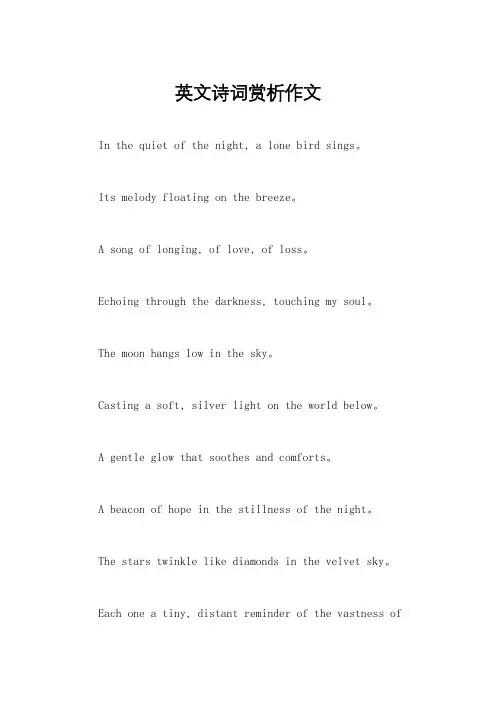
英文诗词赏析作文In the quiet of the night, a lone bird sings。
Its melody floating on the breeze。
A song of longing, of love, of loss。
Echoing through the darkness, touching my soul。
The moon hangs low in the sky。
Casting a soft, silver light on the world below。
A gentle glow that soothes and comforts。
A beacon of hope in the stillness of the night。
The stars twinkle like diamonds in the velvet sky。
Each one a tiny, distant reminder of the vastness ofthe universe。
A reminder of our own smallness in the grand scheme of things。
But also a reminder of the beauty and wonder that surrounds us。
The wind whispers through the trees。
A soft, gentle rustling that speaks of secrets and mysteries。
It carries the scent of earth and leaves, of rain and distant places。
A reminder that there is magic in the world, if only we take the time to listen。
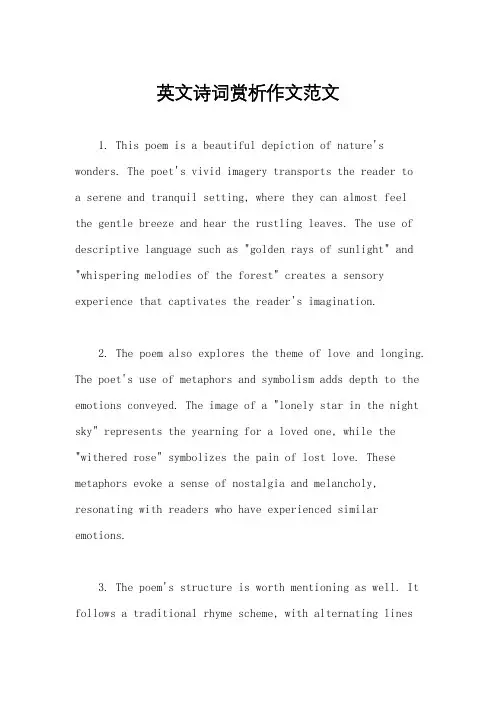
英文诗词赏析作文范文1. This poem is a beautiful depiction of nature's wonders. The poet's vivid imagery transports the reader toa serene and tranquil setting, where they can almost feel the gentle breeze and hear the rustling leaves. The use of descriptive language such as "golden rays of sunlight" and "whispering melodies of the forest" creates a sensory experience that captivates the reader's imagination.2. The poem also explores the theme of love and longing. The poet's use of metaphors and symbolism adds depth to the emotions conveyed. The image of a "lonely star in the night sky" represents the yearning for a loved one, while the "withered rose" symbolizes the pain of lost love. These metaphors evoke a sense of nostalgia and melancholy, resonating with readers who have experienced similar emotions.3. The poem's structure is worth mentioning as well. It follows a traditional rhyme scheme, with alternating linesthat create a melodic flow. This rhythmic pattern adds to the musicality of the poem, enhancing its emotional impact. The use of enjambment, where a sentence or phrase runs over multiple lines, also adds a sense of movement and fluidity to the poem.4. Another notable aspect of this poem is its universal appeal. While the specific details and imagery may vary from reader to reader, the underlying themes of nature, love, and longing are relatable to all. This universality allows the poem to transcend cultural and linguistic barriers, making it accessible and meaningful to a wide range of audiences.5. Finally, the poem's brevity is a strength in itself. In just a few lines, the poet manages to convey a wealth of emotions and paint a vivid picture. This conciseness adds to the poem's impact, leaving a lasting impression on the reader. It also allows for multiple interpretations, as readers can fill in the gaps with their own experiences and emotions.Overall, this poem is a masterful piece of art that combines vivid imagery, emotional depth, and universal themes. Its beauty lies in its ability to transport the reader to another world, evoke strong emotions, and leave a lasting impression. It is a testament to the power of poetry in capturing the essence of the human experience.。
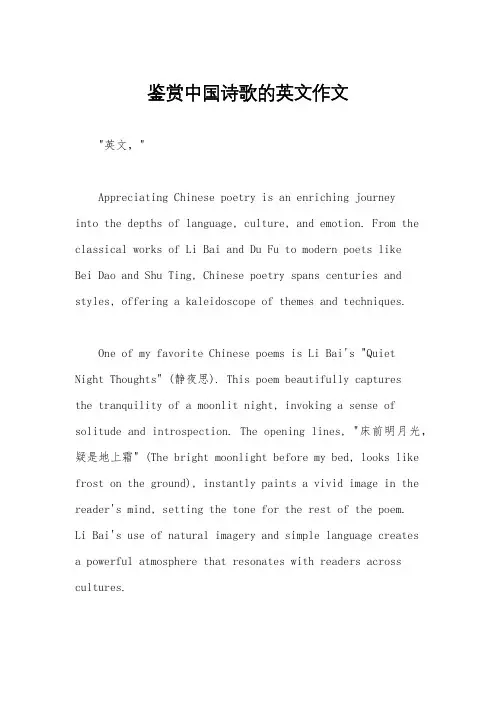
鉴赏中国诗歌的英文作文"英文,"Appreciating Chinese poetry is an enriching journeyinto the depths of language, culture, and emotion. From the classical works of Li Bai and Du Fu to modern poets likeBei Dao and Shu Ting, Chinese poetry spans centuries and styles, offering a kaleidoscope of themes and techniques.One of my favorite Chinese poems is Li Bai's "Quiet Night Thoughts" (静夜思). This poem beautifully capturesthe tranquility of a moonlit night, invoking a sense of solitude and introspection. The opening lines, "床前明月光,疑是地上霜" (The bright moonlight before my bed, looks like frost on the ground), instantly paints a vivid image in the reader's mind, setting the tone for the rest of the poem.Li Bai's use of natural imagery and simple language creates a powerful atmosphere that resonates with readers across cultures.Another remarkable aspect of Chinese poetry is its use of symbolism and metaphor. In Du Fu's poem "Spring Landscape" (春景), the arrival of spring is not merely a change in seasons but a metaphor for renewal and hope. Du Fu writes, "花随流水落,飞燕舞风还" (Flowers fall with the flowing water, swallows dance in the returning breeze), symbolizing the cyclical nature of life and the eternal rhythm of nature.Moreover, Chinese poetry often incorporates philosophical insights and cultural nuances. In Bai Juyi's "Song of Everlasting Sorrow" (长恨歌), the tragic love story of Emperor Xuanzong and his beloved concubine Yang Guifei reflects the ephemeral nature of power and the fleetingness of human existence. The poem's poignant portrayal of love and loss transcends time and speaks to the universal human experience.In conclusion, appreciating Chinese poetry offers a window into the soul of a nation and its people. Through its rich imagery, profound symbolism, and timeless themes, Chinese poetry continues to captivate and inspire readersaround the world."中文,"欣赏中国诗歌是一次丰富的语言、文化和情感之旅。
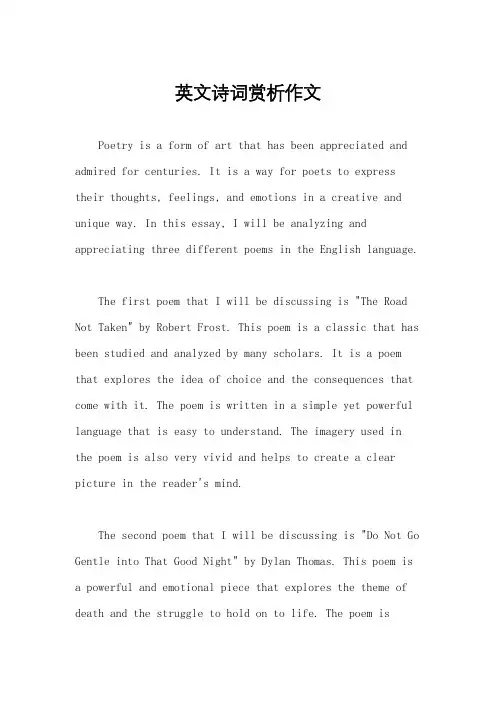
英文诗词赏析作文Poetry is a form of art that has been appreciated and admired for centuries. It is a way for poets to express their thoughts, feelings, and emotions in a creative and unique way. In this essay, I will be analyzing and appreciating three different poems in the English language.The first poem that I will be discussing is "The Road Not Taken" by Robert Frost. This poem is a classic that has been studied and analyzed by many scholars. It is a poem that explores the idea of choice and the consequences that come with it. The poem is written in a simple yet powerful language that is easy to understand. The imagery used in the poem is also very vivid and helps to create a clear picture in the reader's mind.The second poem that I will be discussing is "Do Not Go Gentle into That Good Night" by Dylan Thomas. This poem is a powerful and emotional piece that explores the theme of death and the struggle to hold on to life. The poem iswritten in a very passionate and intense language that conveys the urgency of the message. The repetition of the phrase "Do not go gentle into that good night" adds to the intensity of the poem and emphasizes the importance of fighting for life.The third and final poem that I will be discussing is "Ode to a Nightingale" by John Keats. This poem is a beautiful and lyrical piece that celebrates the beauty of nature and the power of imagination. The language used in the poem is very poetic and musical, and the imagery is very vivid and descriptive. The poem is a celebration of life and the joy that can be found in the simple things.In conclusion, poetry is a powerful form of art that has the ability to move and inspire people. The three poems that I have analyzed in this essay are all unique and beautiful in their own way. Each poem explores different themes and uses different language and imagery to conveyits message. Poetry is a form of expression that will continue to be appreciated and admired for generations to come.。
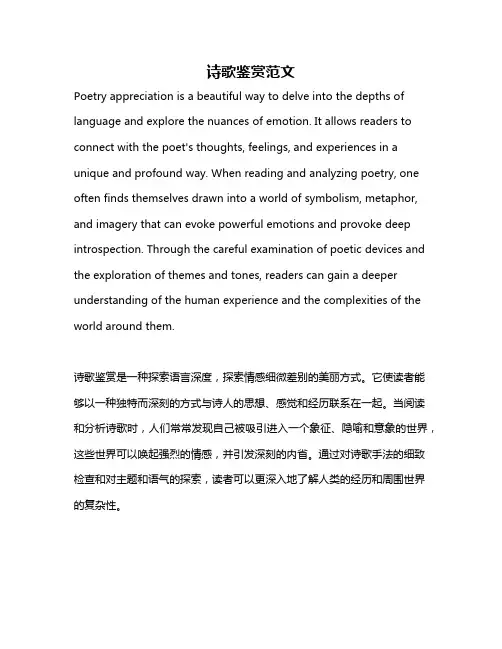
诗歌鉴赏范文Poetry appreciation is a beautiful way to delve into the depths of language and explore the nuances of emotion. It allows readers to connect with the poet's thoughts, feelings, and experiences in a unique and profound way. When reading and analyzing poetry, one often finds themselves drawn into a world of symbolism, metaphor, and imagery that can evoke powerful emotions and provoke deep introspection. Through the careful examination of poetic devices and the exploration of themes and tones, readers can gain a deeper understanding of the human experience and the complexities of the world around them.诗歌鉴赏是一种探索语言深度,探索情感细微差别的美丽方式。
它使读者能够以一种独特而深刻的方式与诗人的思想、感觉和经历联系在一起。
当阅读和分析诗歌时,人们常常发现自己被吸引进入一个象征、隐喻和意象的世界,这些世界可以唤起强烈的情感,并引发深刻的内省。
通过对诗歌手法的细致检查和对主题和语气的探索,读者可以更深入地了解人类的经历和周围世界的复杂性。
Poetry, with its intricate use of language and form, has the ability to capture the essence of human experience in a way that few other art forms can. The careful selection of words, the rhythmic flow of lines, and the use of sound devices all contribute to the unique beauty and power of poetry. As readers immerse themselves in a poem, they are taken on a journey of discovery and reflection, uncovering layers of meaning and emotion that may not be immediately apparent. Through the exploration of themes such as love, nature, death, and identity, poetry provides a lens through which we can better understand ourselves and the world around us.诗歌以其对语言和形式的精妙运用,有能力以很少其他艺术形式能够做到的方式捕捉人类经验的本质。
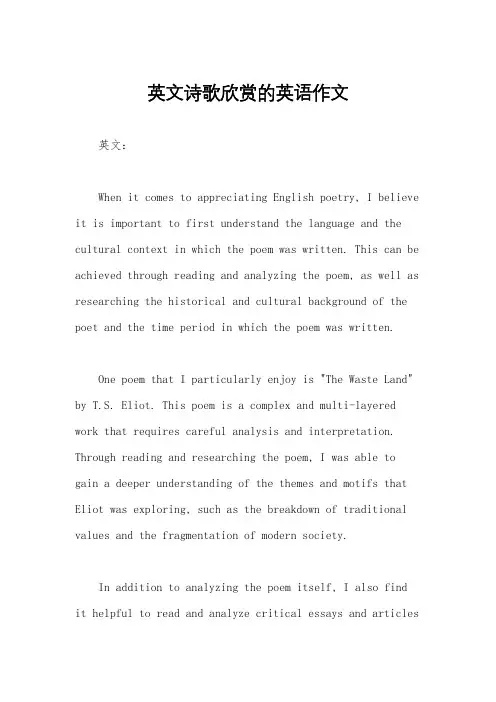
英文诗歌欣赏的英语作文英文:When it comes to appreciating English poetry, I believe it is important to first understand the language and the cultural context in which the poem was written. This can be achieved through reading and analyzing the poem, as well as researching the historical and cultural background of the poet and the time period in which the poem was written.One poem that I particularly enjoy is "The Waste Land" by T.S. Eliot. This poem is a complex and multi-layered work that requires careful analysis and interpretation. Through reading and researching the poem, I was able to gain a deeper understanding of the themes and motifs that Eliot was exploring, such as the breakdown of traditional values and the fragmentation of modern society.In addition to analyzing the poem itself, I also find it helpful to read and analyze critical essays and articleswritten about the poem. This can provide valuable insights and perspectives that may not have been immediately apparent to me upon first reading the poem.Ultimately, I believe that appreciating English poetry requires a combination of careful analysis and interpretation, as well as an openness to exploring the cultural and historical context in which the poem was written.中文:我认为欣赏英文诗歌,首先需要理解诗歌所处的语言和文化背景。
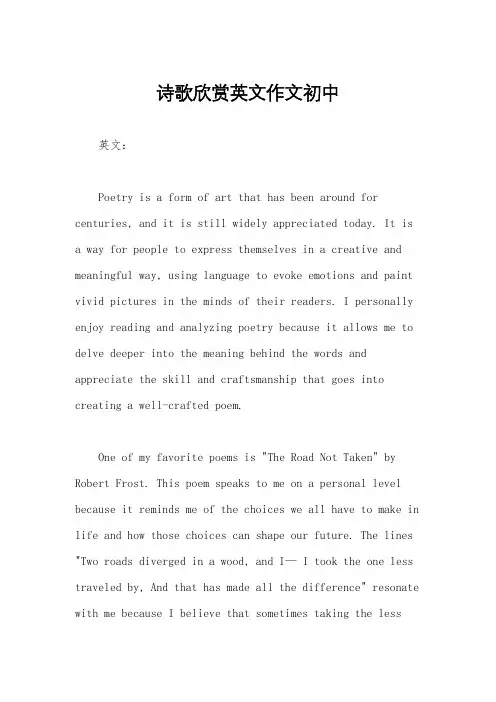
诗歌欣赏英文作文初中英文:Poetry is a form of art that has been around for centuries, and it is still widely appreciated today. It is a way for people to express themselves in a creative and meaningful way, using language to evoke emotions and paint vivid pictures in the minds of their readers. I personally enjoy reading and analyzing poetry because it allows me to delve deeper into the meaning behind the words and appreciate the skill and craftsmanship that goes into creating a well-crafted poem.One of my favorite poems is "The Road Not Taken" by Robert Frost. This poem speaks to me on a personal level because it reminds me of the choices we all have to make in life and how those choices can shape our future. The lines "Two roads diverged in a wood, and I— I took the one less traveled by, And that has made all the difference" resonate with me because I believe that sometimes taking the lesspopular or more difficult path can lead to greater rewards and personal growth.Another poem that I find particularly powerful is Maya Angelou's "Still I Rise". This poem is a celebration of resilience and overcoming adversity, and it inspires me to keep pushing forward even when faced with challenges. The lines "You may shoot me with your words, You may cut me with your eyes, You may kill me with your hatefulness, But still, like air, I'll rise" are a powerful reminder that we are capable of rising above the negativity and hatefulness of others.中文:诗歌是一种已经存在了数百年的艺术形式,今天仍然被广泛赞赏。
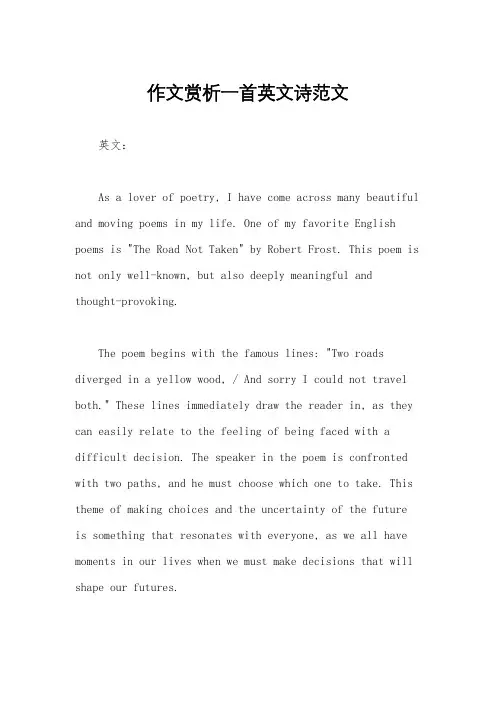
作文赏析一首英文诗范文英文:As a lover of poetry, I have come across many beautiful and moving poems in my life. One of my favorite English poems is "The Road Not Taken" by Robert Frost. This poem is not only well-known, but also deeply meaningful andthought-provoking.The poem begins with the famous lines: "Two roads diverged in a yellow wood, / And sorry I could not travel both." These lines immediately draw the reader in, as they can easily relate to the feeling of being faced with a difficult decision. The speaker in the poem is confronted with two paths, and he must choose which one to take. This theme of making choices and the uncertainty of the futureis something that resonates with everyone, as we all have moments in our lives when we must make decisions that will shape our futures.The poem goes on to describe the speaker's decision-making process, as he looks down one path as far as he can see, and then chooses the other, knowing that he may never have the opportunity to come back and take the first path. This idea of regret and wondering about what could have been is something that many people can relate to. The poem ends with the famous lines: "Two roads diverged in a wood, and I— / I took the one less traveled by, / And that has made all the difference." These lines suggest that the speaker is satisfied with his choice, even though it was the more challenging and unconventional one.I love this poem because it speaks to the idea of individuality and the importance of making our own choices, even if they are not the easiest ones. It encourages us to take risks and not always follow the crowd. The imagery in the poem is also very vivid, and I can easily picture the yellow wood and the two diverging roads in my mind. The language is simple yet powerful, and it has a timeless quality that makes it relevant to people of all ages and backgrounds.Overall, "The Road Not Taken" is a poem that has stayed with me throughout the years, and it continues to inspire me to be true to myself and to embrace the unknown. It is a timeless classic that will always hold a special place in my heart.中文:作为一名诗歌爱好者,我一生中遇到过许多美丽动人的诗歌。
英语诗歌鉴赏论文Poems of W.B. Yeats: The Rose Themes1. IntroductionAs is known to all, Yeats’s poetic thinking is a complexity out of a variety of influences and out of his own originality. Therefore, this study of the Yeatsian poetic thinking would focus on a few distinguished aspects~in order to make themcoherently interrelated, I employ the metaphorical meanings of the rose, a key Yeatsian symbol, to represent those chosen aspects.2. Analysis of the Rose Themes2.1Age and Death2.11 AgeThough a young poet at the time of the composition of The Rose,Yeats is quite preoccupied with themes of aging and mortality. Imagining his old age served as an escape for the young Yeats, who found himself unsuccessful in love and imagined that later in life he would either have won his beloved or his beloved would have come to regret her rejection of him. "In Old Age" is particularly marked by the image of an older Maud Gonne (the woman with whom Yeats was in love) becoming wiser in old age.2.12 DeathYeats also had an anxiety about death which was unusual in someoneso young. He contemplated death less in terms of himself than in termsof his loved ones. When Maud Gonne travel to France as a convalescent, a worried Yeats wrote "A Dream of Death." This meditation on Gonne's possible death is less of a nightmare than a dream comes true, as Yeats envisions himself being useful to her in death as he could not be in life. Yeats, therefore, views both aging and death as more or less positive forces.2.2 Irish MythologyThe Rose is rife with mythological references, from King Fergus to Conchubar to Diarmuid. Indeed, such mythic Irish figures populate nearly every poem in the [1]collection.Mythology operates as a theme in this collection in a number of ways. First and foremost it separates Yeats' poetry from British writing. British writers drew on Roman and Greek mythology - the mythology, in fact, of other (albeit ancient) imperialists. In choosing Irish mythology as his source of allusions and subjects, Yeats creates poetry distinct from that of Ireland's long-time oppressors. This compliments Yeats' desire to cultivate a poetic language suitable to Ireland alone.Moreover, Yeats' use of Irish mythological subjects allows him to avoid the political climate of his own day. Yeats, a moderate comparedto his beloved Maud Gonne, found his political beliefs to be a burden in his pursuit of love. In treating legendary figures, Yeats avoids the problem of referencing the complicated political environment that so tormented him.2.3 Irish NationalismNationalism in Ireland in the 1890s was in a complicated stage. Many die-hard Fenians (Republicans), including Maud Gonne, were more than willing to take armsagainst the British to gain their independence. Another group, including Yeats, took the more cautious parliamentary approach. This political party, called the Home Rule Party, was led by John Redmund and held that Ireland could gain independence [2]through legal means.Because this collection focuses so much on Maud Gonne, Yeats inevitably touches upon his political differences with his beloved. These differences, needless to say, affected their relationship negatively. Yeats feared that Gonne was more repulsed by his moderate politics than by his person.Thus, in some poems, such as "To Ireland in the Coming Times," Yeats seems to be willfully disassociating himself from the complex political fabric of his own era, instead hearkening to a simpler politics of ancient kings. Undoubtedly Yeats was drawn to these ancient mythic times anyway, but his interest takes on a sadness in the context of his relationship with the politics of his own day (and thus of his relationship with Gonne). Nationalist politics exist negatively in these poems, as the subject that Yeats doesn't want to address.2.4 Maud Gonne“A rose of love” refers to the rose as a symbol of love,Loveplayed allimportant part in Yeats ’s personal life as well as in his writing career,In return it isreflected in his poetry and philosophy,On one hand~his unrequited love for MaudGonne fills his poetry, especially those of his early phase~with ardent passion,Theunattainability of his frequently rejected courtship~however, sets a melancholy toneto his love poetry,Also in his early love poems the reader couldfind influence of the[3]courtly love tradition~which he received initially from the pre—Raphaelism,Onthe other hand~his romantic obsession to Gonne contributed considerably to the development of his symbolism,As Yeats himself mentioned~Gonne was the key tohis private symbolism,She is compared to apple blossom due to their commonbeauty and vitality,She is tactically referred to by mere description of her hair, her face~her eyes~her lips~or her “pilgrim soul”,She is the archetype of mostwomen images in Yeats ’s poetry, such as the Countess Cathleen~Helen of Troy,[4]Aengus’s dream lover~Oisin’s wife~Leda~etc,She is also present in manyother nonhuman symbols~including the rose~the tree~the swan~the phoenix~the eagle~etc,Furthermore~not only do those symbolspresent Yeats ’sbeloved in his own poetic way, but they are sufficient to have their own life with regard to their artistic value.The Rose of the WorldWHO dreamed that beauty passes like a dream?For these red lips, with all their mournful pride,Mournful that no new wonder may betide,Troy passed away in one high funeral gleam,And Usna's children died. (Adapted)Yeats wrote this poem to Maud Gonne, with whom he was deeply in love. He often compares her to Helen of Troy, arguing that her beauty, like Helen's, is capable of wrecking turmoil between nations. Indeed, as Gonne is a representative of Ireland, this comparison suggests that her beauty embodies the strife between Ireland and England, which is especially fitting given that Gonne was a fierce Irish nationalist. The reference to Usna's children in the same stanza likens her to Deirdre,an Irish heroine who was destined to bring suffering on the area of Ulster, [5]because too many men fell in love with her.3. ConclusionBy making use of the metaphorical meanings of the rose~this thesisis a studyof several chosen aspects of Yeats’s poetic thinking . Love drastically influenced Yeast’s writing, acting as his source that contributed considerably to the development of his symbolism~Yeats’s mysticism gave the philosophical quality to his poetry~Therefore~this study of Yeats’s poetic thinking might be useful to the Yeatsian scholarship,It is hoped that the thesis would be helpful to readers who seek for a better understanding of Yeats and his times.Works Cited[1] MacNeice, Louis. The Poetry of W.B. Yeats. New York: OxfordUP,1988.[2] Sidnell, Michael J. Yeats’s Poetry and Poetics. Basingstoke:Macmmillan,1996.[3]。
诗词赏析英文作文英文:As a lover of poetry, I find great pleasure in analyzing and appreciating different poems. The beauty of poetry lies in its ability to evoke emotions and convey messages through the use of language and literary devices. In this essay, I will share my thoughts on the art of poetry appreciation and provide examples of poems that have touched my heart.Firstly, when it comes to poetry appreciation, I believe that it is essential to understand the context in which the poem was written. This includes the historical, cultural, and social background that influenced the poet's work. For instance, when reading William Wordsworth's "I Wandered Lonely as a Cloud," it is important to know that it was written during the Romantic era, a time when nature and individualism were highly valued. By understanding the context, we can better appreciate the poem's themes andmessage.Secondly, the use of literary devices such as metaphors, similes, and personification can greatly enhance the beauty and meaning of a poem. For instance, in Emily Dickinson's "Hope is the Thing with Feathers," the metaphor of hope being a bird that never stops singing is both beautiful and powerful. It conveys the idea that hope is always present even in the darkest of times.Lastly, the emotions that a poem evokes are what truly make it a masterpiece. A poem that can make us feel joy, sadness, love, or any other emotion is a poem that has succeeded in its purpose. One such poem that has touched my heart is Langston Hughes' "Dreams." The poem speaks to the aspirations and hopes of African Americans during a time of great oppression. The line "Hold fast to dreams, for if dreams die, life is a broken-winged bird that cannot fly"is a powerful reminder to never give up on our dreams.中文:作为一名诗歌爱好者,我喜欢分析和欣赏不同的诗歌。
英文诗词鉴赏作文模板范文英文回答:In the realm of literary criticism, poetry holds a unique position, transcending linguistic and cultural boundaries to evoke profound emotions and insights. Tofully appreciate the depth and beauty of English poetry, a keen eye for metaphor, symbolism, and rhythm is essential.One of the most striking features of English poetry is its use of figurative language. Poets employ metaphors to create vivid and unexpected connections between seemingly disparate realms, allowing readers to perceive the world from a fresh perspective. In William Blake's "The Tyger," the speaker questions the nature of creation by comparing the fearsome beast to "burning bright" and "the forests of the night." Through this powerful metaphor, Blake forces us to confront the paradoxical nature of existence, where beauty and terror coexist.Symbolism is another indispensable tool in the poet's arsenal. Objects, actions, and even characters can be imbued with deeper meanings, resonating with universal human experiences. In Samuel Taylor Coleridge's "The Rime of the Ancient Mariner," the albatross represents the sanctity of life and the consequences of hubris. By killing the bird, the mariner sets in motion a chain of catastrophic events, underscoring the interconnectedness of all living things.Rhythm and meter are the heartbeat of poetry. The interplay of stressed and unstressed syllables creates distinct patterns that enhance the musicality and memorability of the verse. In John Keats' "Ode to a Nightingale," the poet's longing for escape is conveyed through the lilting rhythms of the poem. The lines "My heart aches, and a drowsy numbness pains / My sense, as though of hemlock I had drunk..." evoke a sense of ethereal beauty and bittersweet yearning.Beyond these technical elements, a comprehensive understanding of English poetry requires a familiarity withits rich historical and cultural context. The Elizabethan era, for instance, witnessed an explosion of poetic innovation, with poets like William Shakespeare and Edmund Spenser experimenting with new forms and language. The Romantic period, in contrast, emphasized emotion, imagination, and a connection with nature, as exemplifiedby the works of William Wordsworth and Samuel Taylor Coleridge.中文回答:在文学批评领域,诗歌占据着独特的地位,它超越语言和文化界限,唤起深刻的情感和见解。
2024年上海初三物理一模汇编:动态电路1、(2024崇明一模)“热敏电阻”控制型动态电路如图1所示的电路,电源电压不变,R 1为热敏电阻,其阻值随温度的升高而减小.闭合开关S ,当监控区的温度升高时,电流表和电压表示数变化的情况是A .电流表示数变大,电压表示数变大B .电流表示数变小,电压表示数变小C .电流表示数变大,电压表示数变小D .电流表示数变小,电压表示数变大2、(2024徐汇一模)图6为烟雾报警器的模拟电路, R 1是滑动变阻器,R c 是气敏电阻,其阻值会随烟雾浓度增大而减小。
当烟雾浓度C 达到8%,电压表示数小于U 0时就会报警。
若要增大该装置对烟雾探测的灵敏度,即烟雾浓度C 达到4%时就报警,下列方案中可行的是 A .增大电源电压 B .向右移动滑片PC .增大电源电压,向右移动滑片PD .减小电源电压,向右移动滑片P3、(2024长宁一模)在图1所示的电路中,电源电压保持不变,电阻R 1、R 2均为定值电阻。
若在电路中添加一个电压表,闭合开关S 前后,发现电压表与电流表示数的比值不变,则电压表并联的位置 A .只能是MN 两点间 B .可能是PN 两点间 C .只能是MQ 两点间 D .可能是PM 两点间4、(2024黄浦一模)在图2所示的电路中,闭合开关S ,电路正常工作。
现对电路分别进行下列操作:①将滑动变阻器滑片向左移;②用电阻R 3(R 3>R 1)替换电阻R 1;③断开开关S ;④增大电源电压。
其中能使电压表示数变大的操作有 A .1个 B .2个 C .3个D .4个图1R 1 R 2VAS监控区 R 1S图6R C V P SR 1 R 2A图1NPMQ图2 VSR 1R 2P5、(2024宝山一模)如图7所示电路,滑动变阻器R 2的滑片P 向右移动时,判断电表的示数变化情况。
小宝同学的分析如下:①滑动变阻器的阻值变大→②电路的总电阻变大→③电流表A 的示数变小→④电压表V 的示数变大。
用英文赏析英文诗作文1. The poem "The Road Not Taken" by Robert Frost is a beautiful exploration of choices and the uncertainty that comes with them. It speaks to the universal experience of standing at a crossroads and having to make a decision, knowing that whichever path we choose will shape our future. The poem's simple language and imagery make it accessibleto readers of all backgrounds, allowing them to connectwith its message on a personal level.2. Frost's use of metaphor in the poem adds depth and complexity to its meaning. The two roads in the poem symbolize the different paths we can take in life, and the speaker's dilemma represents the struggle we all face when making important decisions. By choosing one road over the other, the speaker acknowledges that there will always be a sense of longing for the path not taken, for the opportunities and experiences that could have been.3. The poem's famous last lines, "Two roads diverged ina wood, and I—I took the one less traveled by, / And that has made all the difference," have been widely interpreted and debated. Some see the speaker's choice of the less traveled road as a symbol of individuality and nonconformity, while others argue that it represents the regret and uncertainty that can come with taking the road less traveled. This ambiguity is what makes the poem so powerful and thought-provoking.4. Frost's use of imagery and sensory language throughout the poem creates a vivid picture in the reader's mind. The descriptions of the two roads, one "grassy and wanted wear" and the other "just as fair," evoke a sense of natural beauty and possibility. The speaker's observation of the leaves on the road that had been "trodden black" adds a touch of melancholy and suggests the passage of time and the consequences of our choices.5. The poem's structure, with four stanzas of fivelines each, follows a consistent rhyme scheme (ABAAB) that adds to its musicality and rhythm. This structure, combined with the poem's accessible language and relatable theme,contributes to its enduring popularity and widespread appeal.6. Ultimately, "The Road Not Taken" is a poem that invites reflection and introspection. It reminds us that life is full of choices, and that the paths we take can have a profound impact on our journey. It encourages us to embrace uncertainty and to have the courage to follow our own unique path, even if it means going against the grain.。
诗歌欣赏英文作文1. The moon shines bright, casting its gentle glow upon the earth. It illuminates the night sky, creating a serene and peaceful atmosphere. The stars twinkle in the distance, like tiny diamonds scattered across a velvet canvas. It's a sight that never fails to captivate and inspire.2. The wind whispers through the trees, rustling the leaves and creating a soothing melody. It carries with it the scent of fresh flowers, filling the air with a sweet fragrance. The sound of birds chirping adds to the symphony of nature, creating a harmonious chorus that brings joy to the soul.3. Time passes by in a blink of an eye, like sand slipping through the fingers. Memories are etched in our hearts, like footprints on the shore. Each moment is precious, a fleeting glimpse into the beauty of life. We must cherish every second, for it will never come again.4. Love is a flame that burns bright, warming thecoldest of hearts. It knows no boundaries, transcending language and culture. It is a force that unites us all, connecting souls in a world filled with chaos and confusion. Love is the light that guides us through the darkest of times, giving us hope and strength to carry on.5. Dreams are the wings that allow us to soar, to reach for the impossible. They are the fuel that ignites our passion, pushing us to strive for greatness. Dreams are the whispers of our hearts, guiding us towards our true purpose in life. They are the essence of who we are, the driving force behind our journey.6. Nature is a masterpiece, a work of art that never ceases to amaze. From the majestic mountains to the vast oceans, it is a tapestry of colors and textures. It is a source of inspiration, a reminder of the beauty and resilience of the world we live in. Nature is a sanctuary,a place where we can find solace and peace amidst the chaos of everyday life.7. Laughter is the music of the soul, a symphony that brings joy to our lives. It is infectious, spreading like wildfire and bringing smiles to faces. Laughter is a release, a cathartic experience that lightens the burdens of life. It is a universal language, understood by all, and it has the power to heal and unite.8. Silence is golden, a moment of stillness in a world filled with noise. It is a chance to reflect, to find inner peace and clarity. In silence, we can hear the whispers of our own thoughts, the beating of our own hearts. It is a reminder to slow down, to appreciate the beauty of the present moment.9. Friendship is a bond that withstands the test of time, a treasure that enriches our lives. It is a shoulder to lean on, a hand to hold in times of need. Friendship is a source of support and comfort, a reminder that we are never alone. It is a gift that should never be taken for granted.10. Life is a journey, a rollercoaster ride filled withups and downs. It is unpredictable, full of twists and turns. But it is also a gift, an opportunity to learn, grow, and make a difference. Life is a tapestry of experiences, woven together to create a unique and beautiful story. Embrace it, cherish it, and make the most of every moment.。
A Comparison between Two Nature PoemsAbstract: William Wordsworth, the representative of the romantic writers and great writers of nature. His great imagination, with the poet‟s philosophical and somewhat mystical thought, is deeply rooted in the poetical creation. …To Autu mn” written by John Keats also is an excellent poem about nature. In “To Autumn”, a superficial reading would suggest that John Keats writes about a typical day of this season, describing all kind of colourful and detailed images. In this paper, the two representative poems are examined in terms of figures of speech, imagery skills and theme to appreciate the nature poems.Key words: William Wordsworth; daffodils; nature; to autumnNature poems are an important part of poetry. It chants all creatures great and small in the nature, such as four seasons, plants, animals, mountains and rivers and clouds and rains. Poem writers rooted their great imagination, philosophical and somewhat mystical thought in their creations. By analyzing nature poems, we can appreciate the beauty of poems.1. Figures of Speech Used in DaffodilsPersonification is successfully used in both poems. In the poem “I wandered lonely as a cloud”, the first line makes nice use of personification and simile. The poet assumes himself to be a cloud (simile) floating in the sky. When Wordsworth says in the second line 'I' (poet as a cloud) look down at the valleys and mountains and appreciate the daffodils; it's the personification, where an inanimate object (cloud)possesses the quality of a human enabling it to see the daffodils. The line "Ten thousand saw I at a glance" is an exaggeration and a hyperbole, describing the scene of ten thousand daffodils, all together. Alliteration is the repetition of similar sounds, is applied for the word 'h', in the words - high and hills. In “To Autumn” personification is wildly used. Take the second stanza for example, autumn personified as a harvester, crosses a brook and watches a cider press. Otherwise autumn is listless and even falls asleep. The furrow is "half-reap'd," the winnowed hair refers to ripe grain still standing, and apple cider is still being pressed. However, the end of the cycle is near. The press is squeezing out "the last oozings." Find other words that indicate slowing down. Notice that Keats describes a reaper who is not harvesting and who is not turning the press. Personification here is very successful. It gives autumn a personality and the autumn is no longer abstract.2. Imagery SkillThe poem“In Daffodils” paints images of lakes, fields, trees, stars in Ullswater. Wordsworth continuously praises the daffodils, comparing them to the Milky Way galaxy (in the second stanza), their dance (in the third stanza) and in the concluding stanza, dreams to join the daffodils in their dance. John Keats's “Ode to Autumn” is replete with imagery, each eleven-line stanza of iambic pentameter emphasizing different types of images and different times of day and periods of the personified season. John Keats's “Ode to Autumn” is replete with imagery, each eleven-line stanza of iambic pentameter emphasizing different types of images and different times of day and periods of the personified season. Take stanza one for example, it abounds withvisual images all of which suggest linked ideas of fullness and ripeness. To enumerate, the opening line concludes with "fruitfulness," which evokes images both of trees and other vegetation loaded and heavy with each's particular variety of produce. Readers also sense the juicy ripeness that fills and swells to bursting each different item of fruition. Vines are loaded and blessed with fruit; apple tree branches bend under the weight of fruit ready to be picked; gourds swell, hazel nuts are "plump" with developed kernels; beehives "o'erbrim" with the nectar of a riot of blossoms.3. Title and ThemeThe title, 'Daffodils' is a simple word that reminds us about the arrival of the spring season, when the field is full of daffodils. Daffodils are yellow flowers, having an amazing shape and beautiful fragrance. A bunch of daffodils symbolize the joys and happiness of life. The theme of the poem 'Daffodils' is a collection of human emotions inspired by nature that we may have neglected due to our busy lives. The daffodils imply rebirth, a new beginning for human beings, blessed with the grace of nature. The arrival of daffodils in the month of March is welcome and an enjoyable time to appreciate them! To Autumn has three stanzas. Each of three stanzas shows us different time of a day and different time of autumn. I thought this poem exhibited two kinds of progression of time. First is the time of day. The first stanza is the morning with the "mists". The second is late afternoon, when the hot sun is beating down and makes everyone drowsy. The third is at sunset with the "barred clouds" piercing the sky with its "rosy hue".In the poem “To Autumn”, it shows a progression in the season of autumnitself. The first stanza is early autumn because "summer has o'er brimmed. It shows the maturing of summer‟s bounty. The second is mid-autumn, because it's time for harvest. The third is late autumn because the birds are headed south for winter. From the above, we can see the optimism in the poetry.“Poetry is the spontaneous overflow of powerful feelings: it takes its origin from emotion recollected in tranquility” (Shelley), Poetry teaches us music, metaphor, condensation and specificity. Though the analysis of the nature poems, we can see the beautiful of poems and root the fountain that forever overflowing with the waters of wisdom and delight in mind.Works CitedRoger Gilbert. The Walker‟s Literature Companion. New York: Breakwaw Books;2000: 93.J O Hendry. Rhythm and muse : your friendly guide to English poetry. Johannesburg (56 Chaucer Rd., Lombardy East 2090): Wordsmiths Pub., 1998.R K Sadler; T A S Hayllar; C J Powell. Appreciating Poetry. South Melbourne: Macmillan Education, 1986.李正栓;吴晓梅. 英美诗歌教程[M]. 北京: 清华大学出版社, 2004: 97-99,140-142 孙华祥. 美国文学选读[M]. 北京: 中国社会科学出版社, 2010: 151-155.。